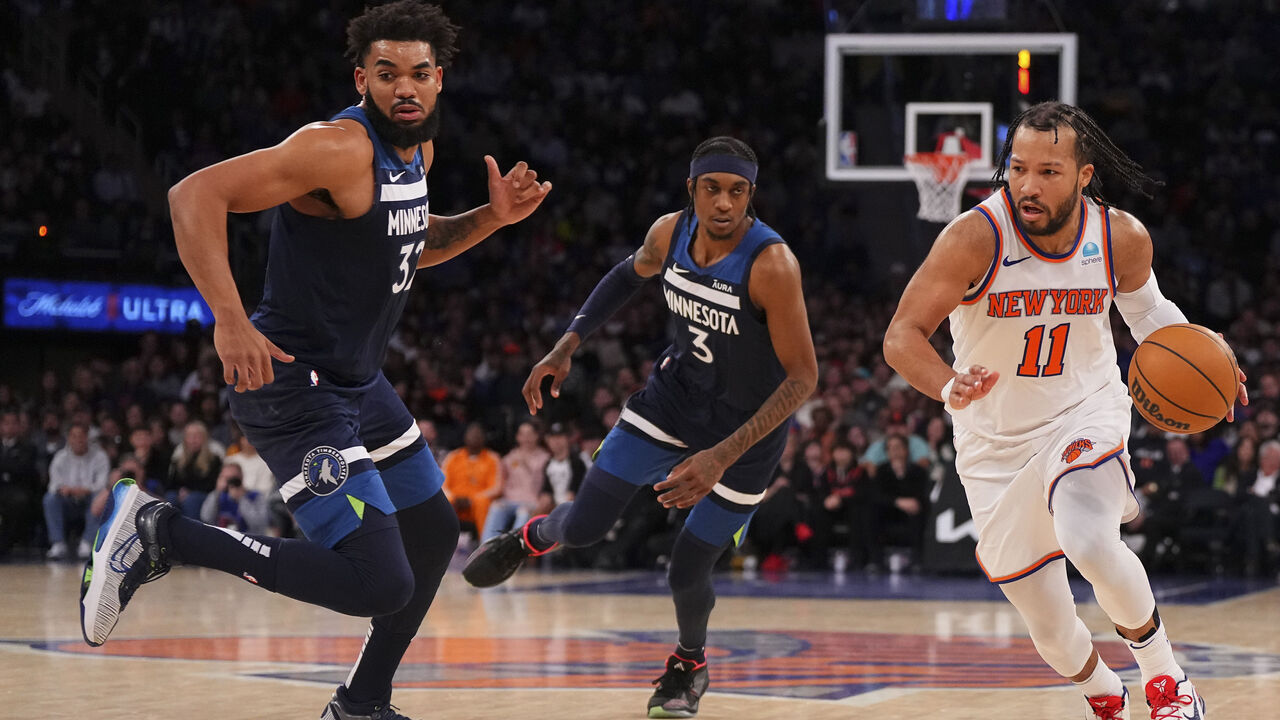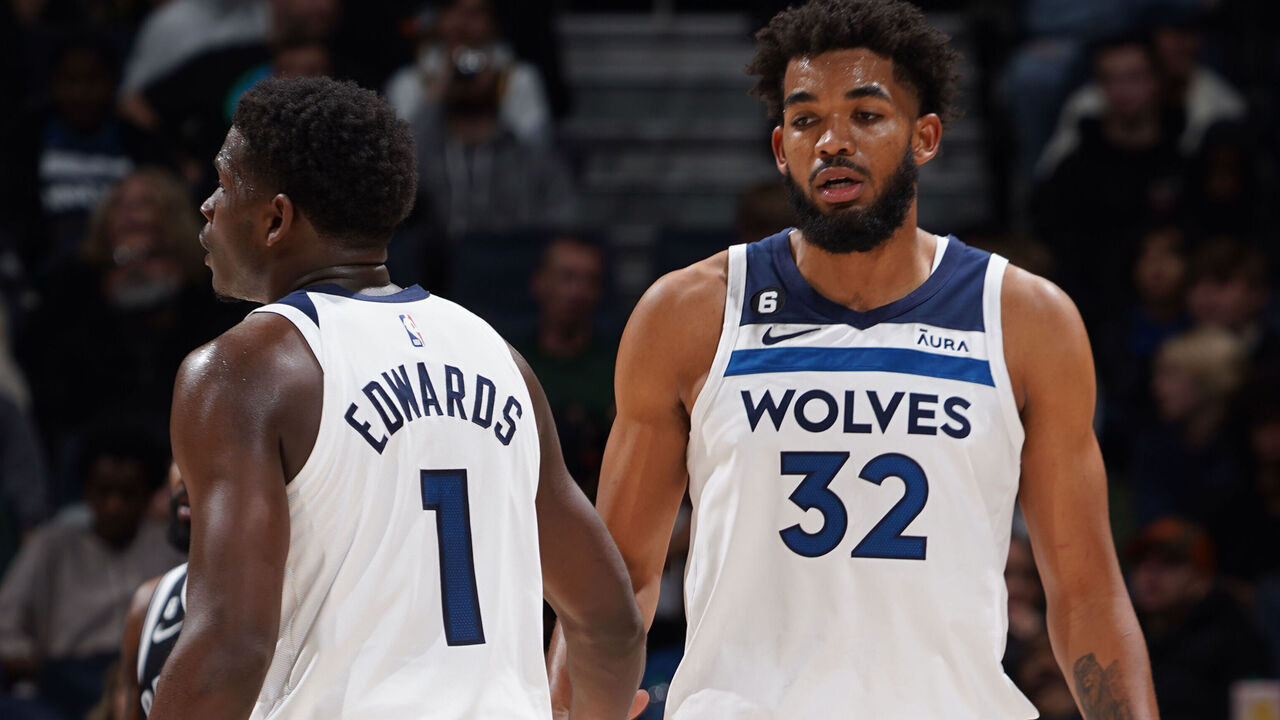The Knicks and Timberwolves sent shockwaves around the NBA on Friday night, agreeing to a blockbuster trade days before training camps open league-wide.
The Knicks continued to cash in their chips in pursuit of the team’s first championship since 1973, sending All-Star power forward Julius Randle, key reserve Donte DiVincenzo, and a first-round draft pick to Minnesota for star big man Karl-Anthony Towns. So, what do we make of the new-look Knicks and Wolves?
Knicks the clear winner, but …
From a basketball lens, this looks like a perfect fit in New York, where Towns could theoretically serve as the missing piece to the Knicks’ championship puzzle.
Though Randle predictably played some of his best ball after the Knicks traded RJ Barrett to open up the floor, there was genuine reason for concern about how the three-time All-Star – and pending 2025 free agent – would coexist on a new-look Knicks team now featuring Mikal Bridges. In a Knicks season-preview piece written prior to this transaction, I asked of Randle: Can a shaky-shooting, defensively inconsistent forward impact winning with less of the ball?
Towns’ otherworldly offensive skill set for a 7-footer means there’s no such concern regarding his fit, with the four-time All-Star a more universal and malleable secondary star. As a career 40% 3-point shooter and floor-spacer, Towns doesn’t need the ball to compromise opposing defenses and positively impact his team’s offense. Still, he can beat teams with the ball in his hands in more ways than Randle can (though Randle’s improved playmaking is worth noting here). A pick-and-roll combination consisting of Towns and star guard Jalen Brunson – with shooters like Bridges and OG Anunoby around them – unlocks countless possibilities for the Knicks and Towns alike.

Defensively, the Knicks can protect Towns in perhaps even more ways than the top-ranked Timberwolves defense did. There are questions to ask of a defense featuring Towns and Brunson, but in Anunoby and Bridges, New Yorks boasts two of the league’s best perimeter and wing defenders. Plus, the Brunson-Towns duo isn’t any more defensively vulnerable than the Brunson-Randle duo was, with Randle originally penciled in for plenty of time at the five while starting center Mitchell Robinson remains sidelined after ankle surgery.
Now when the Knicks go small to start the season, they’ll do so with a more talented and offensively potent quintet, and one featuring a big man in Towns whose size makes him a lot closer to a traditional defensive center than Randle ever would’ve been. Anunoby also remains an option to play as a small-ball five on the defensive end while Towns abuses mismatches as an offensive center. And when Robinson eventually returns, he and Towns can share the frontcourt thanks to Towns’ aforementioned floor-spacing abilities.
Randle was a workhorse – akin to an innings-eater in baseball, even if his flaws made him a tricky fit on a loaded roster. And DiVincenzo was a relentless, two-way guard who was both a fan- and locker-room favorite on this Villanova-heavy squad. New York now needs a lot more from new sixth man Miles McBride. But the Knicks are unquestionably a better and more balanced team than they were before, and they’re wholeheartedly going for it. Such steadfast pursuit of a championship – a quest to end the most famous drought in pro basketball – requires some shrewd decisions and tough goodbyes.
However, the Knicks’ star-studded plan is far from foolproof. This is Towns we’re talking about. For all of his outrageous offensive talents, he’s still prone to bouts of tepid play, indecisiveness, and poor decision-making, especially in the game’s (and season’s) biggest moments. After seemingly exorcising his postseason demons during a heroic performance against Nikola Jokic’s defending-champion Nuggets in the 2023 West semifinals, Towns turned into a pumpkin again in the West finals, shooting 37.9% from the field against Dallas.
Such inconsistency and occasionally uninspiring play was tolerated in Minnesota, where Towns was a beloved franchise lifer. It won’t be at Madison Square Garden, where impatient fans can taste genuine contention for the first time in decades. In addition, any slippage from Towns – who’s cracked the 70-game mark only once in the last five years – will lead to angst that his contract could become unmovable, even if the bargain deals Brunson and Bridges are on make Towns’ salary less of a concern for the Knicks.
On paper, New York won this trade in a landslide. But I won’t be shocked if we’re talking about this as a lose-lose deal six months from now. Such is the KAT experience – a riddle wrapped in a mystery inside an enigma. Can’t win with him. Can’t win without him. The Knicks and Wolves may both be about to find that out. – Joseph Casciaro
Wolves sacrifice frontcourt fit for financial flexibility

There are ways to rationalize this trade from Minnesota’s end in the short and long term, but at first blush this feels like a step backward for a team that just had its most successful season in two decades.
Volatile as his play could be, Towns was deeply embedded in the fabric of the Wolves’ identity. Not only was he their longest-tenured player by far, his expansive skill set was essential to making their double-big frontcourt viable at the offensive end. (They scored 6.2 fewer points per 100 possessions with him on the bench.) And in putting together the best defensive season of his career, especially as a back-side helper behind DPOY winner Rudy Gobert, he also had a big hand in Minnesota’s top-ranked unit at the other end.
Sure, things went haywire for Towns in the West finals in ways that felt all too familiar, but the Wolves wouldn’t have had a prayer of getting there without his two-way contributions, especially in dethroning the Nuggets in the second round. Those contributions included taking on the primary Jokic assignment for that entire series and carrying the Wolves to a Game 7 victory while Anthony Edwards shot 6-for-24. And Wolves fans who had trust issues with Towns in the postseason would be wise not to dig too deeply into Randle’s playoff game tape.
In a vacuum, the gap between Towns and Randle feels pretty negligible. Randle made three All-Star teams and two All-NBA teams across his five seasons in New York. He’s a more polished playmaker, a better defender in space, and an all-around more physical presence than Towns is. But when it comes to fitting them around other players, the gulf widens in favor of Towns, whose adaptability and off-ball utility make him an ideal complementary star. His superior size also makes him more viable as a center, whereas Randle can only really play the four.
The Randle-Gobert frontcourt fit is going to be offensively tenuous, especially with Jaden McDaniels (a competent but low-volume 3-point shooter) playing alongside them at the three. Randle’s a somewhat credible 3-point shooter, but not one defenses feel compelled to respect on the perimeter. Take away his outlier 2020-21 season and he’s at 31.6% for his career. And that’s to say nothing of his penchant for stopping the ball and jab-stepping his way to 18-foot jumpers.
This was a middle-of-the-road offense (17th in the regular season) even with Towns there to provide Edwards and Mike Conley a deadly pick-and-pop partner, and use his spot-up gravity to open the floor for Gobert’s rim rolls. In order for Randle to be effective on offense, he’ll need to touch the ball a lot more than Towns did, and he and Gobert will need to develop some high-low passing synergy in a hurry. His fit with Naz Reid feels a bit cleaner, and that tandem could unleash hell on opposing transitional lineups, though defense could be a concern given neither is much of a rim-protector.
The DiVincenzo addition goes some way toward salvaging this trade for the Wolves. (The Pistons first-rounder they acquired also adds a much-needed arrow to a draft quiver that was completely depleted by the Gobert trade, but it’s heavily protected and may not convey for several years.) They badly needed more guard depth, and while DiVincenzo isn’t the kind of ball-handler or passer who can serve as an insurance policy for the soon-to-be 37-year-old Conley at the point, he brings a nice balance of on- and off-ball skill, along with nasty point-of-attack defense that’ll fit very well with this group. The rearview pressure he applies as a chaser over screens should pair especially nicely with Gobert in drop coverage.
Losing Towns’ shooting in the frontcourt obviously stings, and there’s inherently less value in adding a comparable shooter in the backcourt. Still, it’s worth noting that DiVincenzo shot 40% on 8.7 3-point attempts per game last season. If he can replicate that level of volume and efficiency, the Wolves’ offense may be fine. He’s also on a ridiculously team-friendly contract that runs three more years, which was surely a big selling point for Minnesota.
Towns’ four-year, $220-million extension kicks in this season, and it’s clear the luxury-tax crunch coming the Wolves’ way was a big part of their calculus here. But even as a cost-cutting maneuver, this puts them in a complicated spot. Randle’s on an expiring deal, so the team’s options may boil down to letting him walk for nothing next summer (which would mean they traded a franchise cornerstone for one quality role player, one so-so pick, and one Randle season) or giving him a new contract that could push them into deep-tax territory anyway.
They could try to go the in-season trade route, but I’m not sure they’ll love the offers they get for Randle, given the aforementioned fit issues baked into his game. Their best hope may be that the lack of cap space and/or interest around the league allows them to extend or re-sign him on an affordable medium-term deal.
All in all, it’s a fascinating trade, and one that could prove beneficial for Minnesota in the long run. For now, it’s a bit of a tough pill to swallow considering how close this team just got to the top of the mountain. It would’ve been nice to see the same core group get another chance to scale it together. – Joe Wolfond






